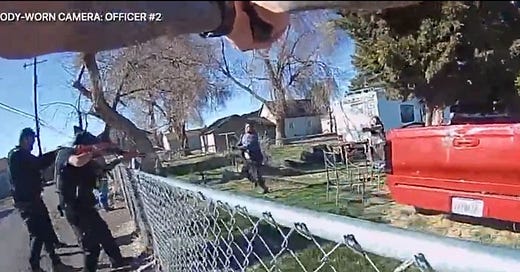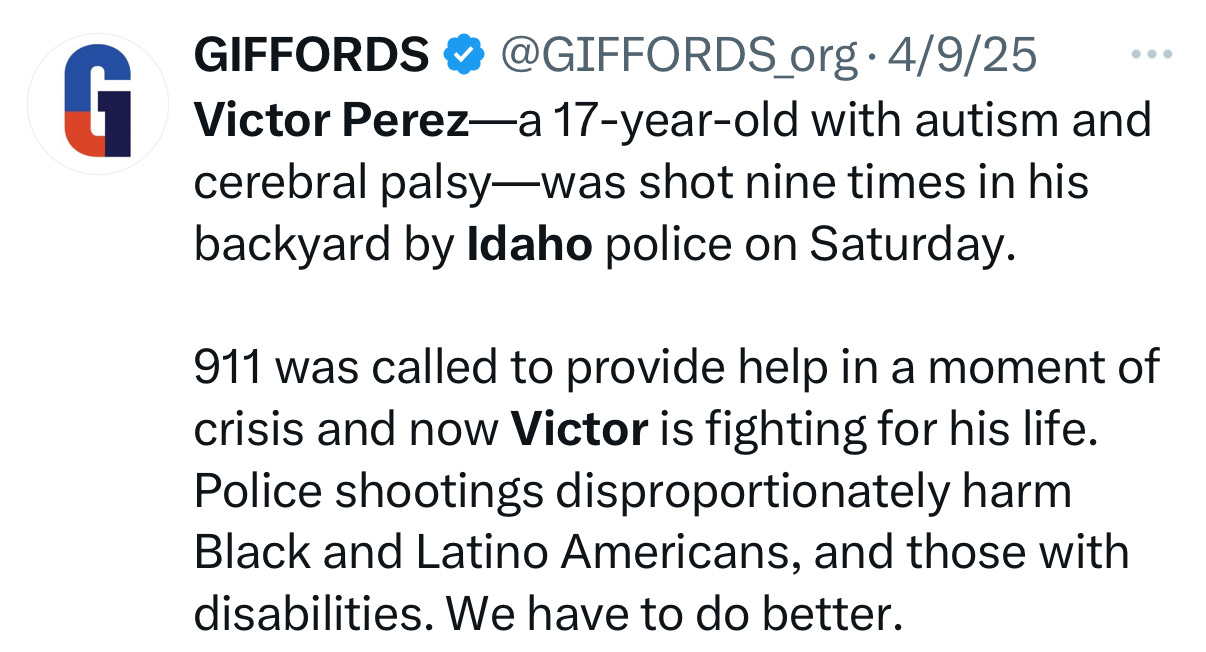A seventeen-year-old was fatally shot by police in Pocatello, Idaho.
The teenager (Victor Perez) had autism, cerebral palsy, was nonverbal, and had the mental acuity of a five-year-old.
However, none of that factual medical information is relevant when evaluating the reasonableness of this Officer—Involved-Shooting (OIS).
What Happened
the 911 call
On April 5th, 2025 police officers in Pocatello, ID were dispatched to a call in reference to a disturbance.
The caller was a man who worked at a shop in the area and he reported the incident to 911 dispatch.
Here is what the police were told:
A man and a woman were being attacked in the backyard of a residence.
The attacker was another man.
The attacker was “brandishing a knife”.
The attacker was “trying to stab someone”.
The attacker appeared to be “under the influence”.
The attacker was “chasing” the victims.
One of the victims hit the attacker on the head with a “log”.
The attacker was “trying to stab everybody”.
the arrival
Police officers arrived on scene and observed that Victor Perez was on the ground - holding the knife. Perez was inside the fence and two women were within a few feet of him. Officers gave him multiple commands to “drop the knife”. Perez stood up and began to advance towards police officers - who were outside of the fence-in yard.
the use of force
Three officers discharged their duty weapons and one officer deployed a round from a less lethal bean bag shotgun. Perez then fell to the ground - still clutching the knife. Perez died on April 12th after undergoing several surgeries - including a leg amputation.
911 call, surveillance footage, body cam
What the Cops Knew
Since this OIS the medical history of Perez has been at the center of the discussion. Commentators, influencers, and the media have been excoriating the police for not dispatching a “crisis intervention team”/mental health counselor to help de-escalate the situation as well as for “executing” a disabled teenager in his own yard.
Those questions and concerns may be valid but have a very simple answer.
The police had no idea that they were responding to a disabled teenager in the throes of a mental health crisis.
The police are not psychic.
If police are dispatched to a call where it is reported that a man with a knife is trying to stab multiple people - they will respond as you would expect.
If police are dispatched to a call where a teenager is in crisis and no one is in immediate danger - the public should expect a far different response.
When the only call for police assistance is from a concerned neighbor - the police will respond with the intent to ensure that no innocent person is stabbed to death.
If the public wants police officers to treat incidents like this as a mental health crisis - then someone has to call and inform dispatch of this information. No honest broker can hold the police officers accountable for information that they were not privy to.
This why the factual medical information is not relevant when evaluating this case.
First
When I first viewed the video of this incident I quickly formed the opinion that the use of deadly force in this case was “not objectively reasonable”. I made several social media posts to that effect.
My main sticking point - the fence between Perez and police.
That fence is still the most difficult part of the analysis of this case.
Analysis
Now that we all agree that this OIS must be evaluated based on the information that the officers possessed at the time of the use of deadly force - lets move forward with the analysis.
There are several different standards to keep in mind when evaluating a use of force incident:
The civil standard of “objective reasonableness” as established by the SCOTUS in Graham v. Connor.
State and federal law.
Department policy.
the Graham Standard
Any analysis of an excessive force claim should consider whether the search or seizure was objectively reasonable, based on how a reasonable police officer would have handled the same situation.
Factors include: the severity of the crime, the threat posed by the individual to the safety of officers or other people, and whether the individual is trying to flee or resist arrest.
Perez was trying to stab other individuals and advanced towards police with a knife.
There is almost no more serious crime.
Perez was not an immediate threat to police as he advanced towards officers - with a fence in between them.
Perez’s actions at the time of the OIS would be classified as an “imminent threat” as the deadly threat was about to unfold but not yet actively occurring.
Perez was actively resisting lawful arrest while armed with a deadly weapon.
The preponderance of the evidence would lead a reasonable person to believe that the use of deadly force was objectively reasonable under the “Graham standard”.
Idaho state law
Under the Idaho law (18-4011) that governs police use of deadly force - deadly force is permitted if the officer, “has probable cause to believe that the resistance poses a threat of death or serious physical injury to the officer or to other persons.”
Advancing aggressively towards police officers, while armed with a knife, after attempting to stab other individuals, does pose a threat of serious physical injury or death.
Therefore, this use of deadly force should be classified as a “justifiable homicide”.
department policy
The use of force policy (300.4(a)) of the Pocatello Police Department states, “An officer may use deadly force to protect themself or others from what the officer reasonably believes is an imminent threat of death or serious bodily injury.”
There was an imminent threat of death or great bodily injury.
Therefore, there was no violation of department use of force policy.
Conclusion
The use of deadly force was not in violation of state law, within department policy, and objectively reasonable.
A suggestion that officers deploy less lethal force, wait to see if effective, and then evaluate the need for deadly force is not unreasonable. It is just not required under the law or department policy.
Still. I struggle with the fence that separated Perez from the officers. Let’s evaluate this issue further.
That F*cking Fence
If that fence were not in between police officers and Perez - this would be an obviously reasonable use of deadly force. There would be zero question.
So, just how much weight should be put on the presence of a fence?
How far away was Perez from then fence?
Less than 10 feet.
How long would it take the average person to reach the fence?
1-2 seconds.
How long would it take the average person to climb/scale the fence?
1-2 seconds.
Therefore, the time/distance between Perez and police was approximately 3-4 seconds. Perez was 3-4 seconds away from having the ability to deliver a deadly attack upon police officers.
So, the question is: How close do police officers have to allow a deadly threat to get to them?
1 second? 3 feet? Obviously not.
*Also, if Perez had turned his attention towards the individuals that he had just been trying to stab (who were only a few feet away from him) the fence would have made it more difficult for police officers to render aid or effect an arrest.
**And, Perez had the ability to throw the knife at the officers - which would be considered a deadly threat.
How do we…
Reasonable people will quickly move past the initial itch to solely blame the police officers. Even if this use of force incident was objectively reasonable - the outcome is still awful and we should all want something different for future similar scenarios.
Police departments (including the Pocatello Police Department) are staffed with crisis intervention (CIT) certified officers. Some larger agencies have mental health crisis teams - where a CIT officer and a mental health counselor respond as a team (once a situation is safe). However, if police dispatch is not provided the information that an incident involves a mental health crisis - there is no way for those specially trained officers/teams to be dispatched.
If a person is in the throes of a mental health crisis and armed, here are some suggestions:
Call the police and request a CIT officer.
(Try to) ensure that everyone else is safely away from danger.
If police arrive on scene and perceive an imminent threat to life - they will act in accordance to their training and attempt to stop the threat.
Trying to intervene in between police and a man with a knife is a bad idea.
Police do not know the intimate dynamics that exist within every family and may use force to protect.
The less people on scene that may be injured by a knife-wielding suspect - the more energy and focus the police can put towards de-escalation.
What you think is helpful intervention is really distracting interference.
Final Thoughts
The goal is to avoid outcomes like this. Every serious discussion should include this principle.
Solely blaming the police is lazy and dishonest
When an armed individual with a knife aggressively advances towards police officers while refusing to follow commands - this puts the officers in an awful position. They can be stabbed within a few seconds or have the weapon thrown at them in an instant. The notion that police officers will not respond to an imminent deadly threat with deadly force is juvenile.
The fence is not a magic barrier - it represents 3-4 seconds. Think about that.








I'm glad to see you've come around to my thoughts on this situation. That fence is not an insurmountable object, not to the justification for the use of force nor, in the officers point of view based on what they knew at that exact moment, to the suspect himself. It was a flimsy fence, it was at best 4 ft high, the officers had rushed directly up to the fence and earlier video had shown the subject reaching 3 ft over that fence to swing the knife at his grandfather who responded with, wait for it, wait for it... deadly force by striking him in the head with a log! If we can't fault the grandfather then why would we fault police? The grandfather was well aware of his infirmities and his condition, the police were not. Not only were the police having to deal with action versus reaction, the subject suddenly jumping up and charging at them and him being able to clear that distance in one or two seconds, there were also two other people inside of that fence line. Of course, we never know what's going to happen with uninvestigation particularly a high-profile situation like this where there's a lot of speculation and what ifs, but the way I see this is that under the circumstances known to the officers at the time, this was justified. When you add in the fact that all four officers fired nearly simultaneously that tells us that all four officers on scene perceived the exact same threat at nearly the exact same time and reacted the exact same way. It doesn't get much more reasonable officer standard than that.
It's a shame that the young man in question got killed, however when a situation with people in immediate danger of being harmed by somebody with a weapon officers will act upon how they were taught. The laws of the State of Idaho did give these officers the clearance to stop the threat, which is what a big part of their job is.
In a mental health crisis situation it should be made clear to dispatch so that they can get the people on scene that are needed.
If a weapon is mentioned in any part of the call the officers will already be on high alert, and somebody who does not drop a knife, gun or any weapon in general when ordered to does fall into a category that often necessitates use of force.